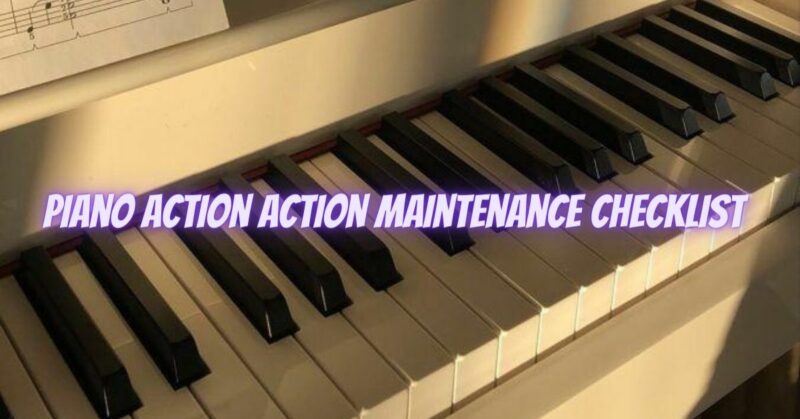Maintaining a piano action is crucial for ensuring the instrument’s optimal performance and longevity. Regular maintenance helps keep the action responsive, consistent, and free from issues that may affect playability and sound quality. Here’s a piano action maintenance checklist to help you keep your piano in excellent condition:
- Regular Cleaning:
- Dust the keyboard and action regularly with a soft, lint-free cloth to prevent debris from affecting the keys’ movement.
- Keep the Environment Stable:
- Maintain consistent temperature and humidity levels in the room to prevent wood expansion or contraction, which could affect the action’s regulation.
- Tune the Piano Regularly:
- Regular tuning by a professional piano tuner ensures that the strings and hammers are in proper alignment, contributing to a well-regulated action.
- Inspect for Wear and Tear:
- Periodically check the hammers, dampers, and other action components for signs of wear, damage, or misalignment.
- Regulate Key Dip:
- Verify that the key dip (the distance a key travels when pressed) is consistent across all keys. Adjust as needed to maintain even touch response.
- Check Let-Off:
- Ensure that the let-off (the point at which the hammer disengages from the string) is properly regulated, providing proper escapement.
- Hammer Alignment:
- Regularly check the alignment of the hammers to ensure they strike the strings squarely and evenly.
- Check for Noisy Keys:
- Address any keys that produce unwanted noise or squeaking during play. Lubricate friction points or repair worn parts as necessary.
- Regulate Escapement:
- Adjust the escapement mechanism to ensure that the hammer rebounds correctly after striking the string.
- Check Damper Functionality:
- Verify that the dampers lift and fall smoothly, allowing strings to vibrate freely when keys are released.
- Inspect Key Leveling:
- Ensure that the keys are level across the keyboard to maintain consistent touch and feel.
- Check for Sticking Keys:
- Address any keys that stick or do not return to their original position promptly. Adjust or repair as needed.
- Keep the Action Lubricated:
- Use appropriate piano action lubricants to maintain smooth and silent action movement.
- Seek Professional Service:
- For comprehensive maintenance and regulation, consult a skilled piano technician or piano specialist at least once a year or as recommended by the manufacturer.
Remember that piano action maintenance is a delicate task and may require expertise. If you’re unsure or encounter significant issues, it’s best to seek the assistance of a qualified piano technician to ensure your instrument receives the proper care and attention it deserves. Regular maintenance and a well-regulated action contribute to a rewarding playing experience and help preserve the piano’s value and performance for generations to come.


